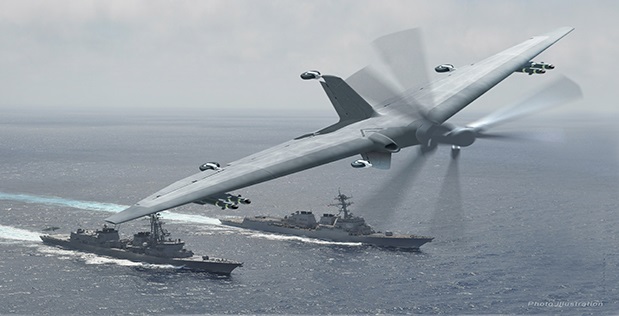Integrating the ability to launch an unmanned air system (UAS) and a moving launch pad would increase the effectiveness of this UAS, especially if it came from the more abundant small-deck ships that can maneuver more deftly than carriers. These destroyers and frigates could greatly increase their effectiveness with UASes to provide intelligence, surveillance and reconnaissance, and other capabilities at long range around the clock. However, current state-of-the-art UASes lack the ability to take off and land from confined spaces in rough seas and achieve efficient long-duration flight. The Tactically Exploited Reconnaissance Node (TERN ) is a joint program between DARPA and the U.S. Navy’s Office of Naval Research (ONR) that seeks to provide these capabilities. As part of TERN’s progress toward that goal, DARPA has awarded Phase 3 of TERN to a team led by Northrop Grumman .

DARPA and a team led by the Northrop Grumman plan to build a full-scale demonstrator system of a medium-altitude, long-endurance unmanned air system (UAS) designed for use from forward-deployed small ships.
The first two phases of TERN successfully focused on preliminary design and risk reduction. In Phase 3, DARPA plans to build a full-scale demonstrator system of a medium-altitude, long-endurance UAS designed to use forward-deployed small ships as mobile launch and recovery sites. Initial ground-based testing, if successful, would lead to an at-sea demonstration of takeoff, transition to and from horizontal flight, and landing—all from a test platform with a deck size similar to that of a destroyer or other small surface-combat vessel. TERN could open up future capabilities for Navy small-deck surface combatants and U.S. Marine Corps air expeditionary operations.
The TERN Phase 3 design envisions a tail-sitting, flying-wing aircraft with twin counter-rotating, nose-mounted propellers. The propellers would lift the aircraft from a ship deck, orient it for horizontal flight, and provide propulsion to complete a mission. They would then reorient the craft upon its return and lower it to the ship deck. The system would fit securely inside the ship when not in use. Testing would include wind tunnel tests followed by development of a full-scale prototype for sea trials on a decommissioned warship. For more information, visit http://tinyurl.com/hnxs95j.
Advertisement








